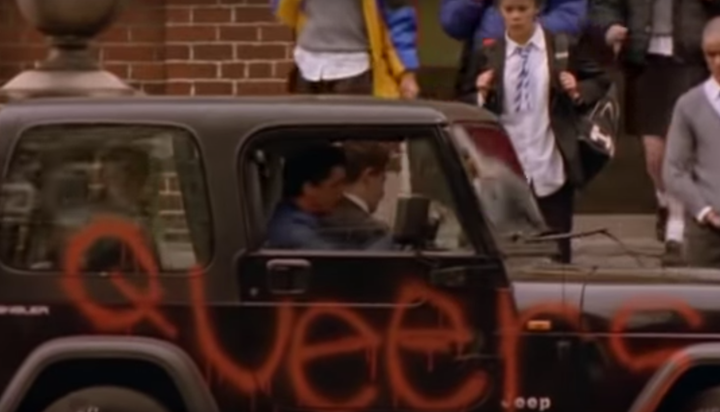The reaction when I tell people that I’ve never watched Queer As Folk is invariably one of shock, followed immediately by: “Oh… you’ll love it.”
Despite never having actually seen Queer As Folk, I still know a lot about the show and its impact – namely that it broke new ground in the 90s in terms of queer representation on British TV (and globally, with the show going on to inspire a US spin-off), that it centres around a group of gay friends in Manchester and that there’s a questionable age-gap romance.
Oh, and there’s rimming in it.
So, as the show celebrated its milestone 21st birthday, it felt like an appropriate time to finally give it a whirl, and watch at least one episode of the show that paved the way for so many other LGBTQ-centric films and TV series that I’ve watched and loved over the years.
So, was every gay man who’s ever told me that I’d “love it” right? Sort of.

The first thing I have to say after diving straight into the first episode of Queer As Folk is that they were not messing around when it came to those sex scenes. In the past, I’ve heard countless references to the show’s graphic content (including that aforementioned rimming scene), but always assumed people were just talking in comparison to today’s standards.
Not the case at all, as it turns out. Were Queer As Folk to debut in 2020, I’m confident it would still have certain viewers clutching their pearls, and I daren’t imagine what the Daily Mail comments section would have to say about the more explicit moments.
And as for the infamous rimming scene, the only other time I ever recall the act being mentioned in a scripted series is that Sex And The City episode where Miranda is disgusted by it, then gets into it, but refuses to do it back to the man she’s seeing.
More recent shows like Netflix smash Sex Education, much-loved US series Looking and the Australian comedy Please Like Me have done their bit in terms of depicting other taboo areas of sex between men on screen, but none have “gone there” when it comes to rimming quite as much as Queer As Folk, which is pretty impressive given it came out more than 20 years ago, and the moment in question happens about 15 minutes in.
Speaking of the show’s history, I have to also say that compared to other British shows of its time, Queer As Folk has aged pretty well.
Even in moments that are so deeply rooted in 1999 – Vince chatting about a former conquest who had “every episode of Juliet Bravo on tape”, references to VHS pornography and, indeed, a gym-fit man apparently being a gay scene anomaly – are actually charming, and feel like they’re just painting a deeper picture of when the show is set, rather than making you cringe with their out-datedness.
And on the subject of nostalgia, the character of teenager Nathan (played brilliantly by a very young Charlie Hunnam) no doubt served as a reminder to so many viewers in 1999 of their first experiences out in an exclusively LGBTQ area - in this case, Manchester’s Canal Street.
Like the character, I was 15 the first time I went out on Newcastle’s gay scene, and seeing Nathan’s combination of feeling nervous and intimidated mixed with relief is something that was very familiar to me.
There’s a lot of conversation about how the LGBTQ scene has changed since the time of Queer As Folk – largely put down to the invention of social media, the prevalence of dating and hook-up apps and the need for greater representations of all queer identities – but the naivety of Nathan (“what do you like?” “I like watching telly”), is something I imagine will be relatable to anyone who has ever had to step out of their comfort zone as a young person to find their own tribe.
But there is, of course, one element of the show which I’m not sure holds up in 2020, and that’s the fact – as mentioned already – Nathan is only 15 years old. Whereas Stuart, who takes him home on his first night out on the gay scene is… well, he’s not 15, is he? In fact, he’s a new father, and his friends’ reaction to the news he’s just had sex with a teenager is “you both had a child on the same night”.

Stuart is also completely nonplussed to discover his new pal is actually not just underage but hasn’t even started his GCSEs yet. Neither are his friends, apparently, with Vincent even driving Nathan into school the following morning.
I’ll admit that I only watched the first episode, but from the preview of what was to come, it looked like there was a lot more to come from Stuart and Nathan’s “romance”, and for that reason alone, I’m honestly not sure quite how comfortable I’d be pursuing the show any further.
Queer As Folk obviously broke new ground in terms of queer representation on screen and telling stories of LGBTQ people, and for those who enjoyed it first time around, when there were so few shows like it, it must hold fond and important memories.
Similarly, I’m aware that Nathan’s experience as a teenager is one that a lot of people will relate to, and his is a story worth telling.
But I must admit, the impression I get of what’s to come in the rest of the series is not that Stuart is going to be held accountable for his inappropriate (and illegal) actions any time soon (seriously, not a single one of his friends had anything to say about how etnically – and indeed legally – dubious his actions had been).
And so I must admit, I’m happy that in 2020, there are a greater variety of queer stories out there besides ones that centre around a love story that makes me so uneasy.
This article has been amended to correct a typo.

